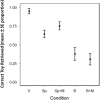Sound quality impacts dogs' ability to recognize and respond to playback words
- PMID: 40295562
- PMCID: PMC12037911
- DOI: 10.1038/s41598-025-96824-8
Sound quality impacts dogs' ability to recognize and respond to playback words
Abstract
Humans show a remarkable ability to recognize degraded speech, but they struggle as degradation becomes more severe. Research on dogs, a species naturally exposed to human language, has suggested that also in this species, the level of degradation may negatively correlate with familiar speech recognition. The quality of sound playback equipment is crucial in canine research to ensure accurate reproduction, directly impacting dogs' receptivity. In citizen science, availability, operability, and affordability are also key. However, the varying level of sound degradation of commercially available devices may impact dogs' recognition of the played-back sounds. This study evaluates how different audio devices affect the response to human speech in dogs. Study 1 tested dogs' responses to trained verbal action cues delivered via Augmentative Interspecies Communication (AIC) buttons, loudspeakers, and direct human speech. Study 2 tested Gifted Word Learner (GWL) dogs' accuracy in retrieving named toys using the same devices. Study 3 investigated whether GWL dogs could learn new toy names through recorded voice played via loudspeakers and generalize these to direct human speech. Results consistently showed that dogs' responses to verbal cues were significantly affected by the device type, with the best performance observed for direct human speech and the lowest performance for AIC buttons. Our findings show that the level of sound degradation significantly affects dogs' recognition of recorded speech and suggest that current commercially available AIC devices are not recommended for testing effective recognition of the recorded words.
Keywords: Audio quality; Augmentative interspecies communication (AIC); Dog; Sound processing equipment; Vocal recognition.
© 2025. The Author(s).
Conflict of interest statement
Declarations. Competing interests: The authors declare no competing interests. Informed consent: The owners gave their informed consent for participating with their dogs in the study.
Figures




Similar articles
-
The acoustic bases of human voice identity processing in dogs.Anim Cogn. 2022 Aug;25(4):905-916. doi: 10.1007/s10071-022-01601-z. Epub 2022 Feb 10. Anim Cogn. 2022. PMID: 35142977 Free PMC article.
-
How do soundboard-trained dogs respond to human button presses? An investigation into word comprehension.PLoS One. 2024 Aug 28;19(8):e0307189. doi: 10.1371/journal.pone.0307189. eCollection 2024. PLoS One. 2024. PMID: 39196871 Free PMC article.
-
Dog-directed speech: why do we use it and do dogs pay attention to it?Proc Biol Sci. 2017 Jan 11;284(1846):20162429. doi: 10.1098/rspb.2016.2429. Proc Biol Sci. 2017. PMID: 28077769 Free PMC article.
-
How do auditory cortex neurons represent communication sounds?Hear Res. 2013 Nov;305:102-12. doi: 10.1016/j.heares.2013.03.011. Epub 2013 Apr 17. Hear Res. 2013. PMID: 23603138 Review.
-
Adapting to the human world: dogs' responsiveness to our social cues.Behav Processes. 2009 Mar;80(3):325-33. doi: 10.1016/j.beproc.2008.11.002. Epub 2008 Nov 14. Behav Processes. 2009. PMID: 19056474 Review.
Cited by
-
Let's talk about "talking" dogs! Reviewing the science behind a bold idea.Biol Futur. 2025 Jun;76(2):273-291. doi: 10.1007/s42977-025-00276-0. Epub 2025 Jul 29. Biol Futur. 2025. PMID: 40728764 Free PMC article. Review.
References
-
- Mattys, S. L., Davis, M. H., Bradlow, A. R. & Scott, S. K. Speech recognition in adverse conditions: A review. Lang. Cogn. Processes. 27, 953–978 (2012).
-
- Shannon, R. V., Zeng, F. G., Kamath, V., Wygonski, J. & Ekelid, M. Speech recognition with primarily temporal cues. Science270, 303–304 (1995). - PubMed
-
- Mallikarjun, A., Shroads, E. & Newman, R. S. The cocktail party effect in the domestic dog (Canis familiaris). Anim. Cogn.22, 423–432 (2019). - PubMed
MeSH terms
LinkOut - more resources
Full Text Sources

